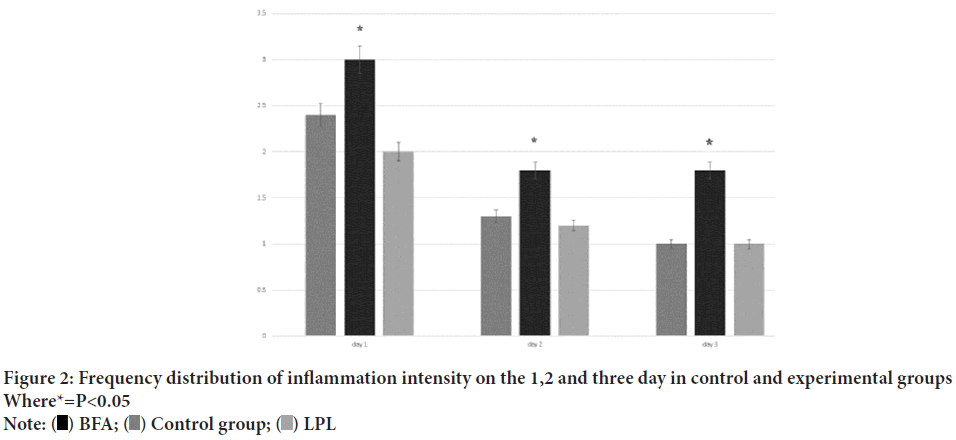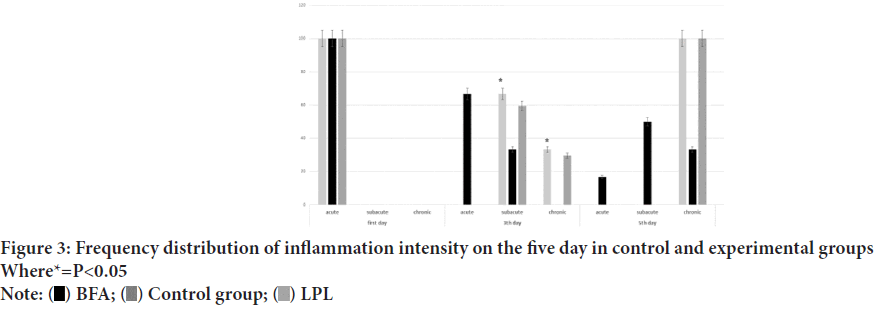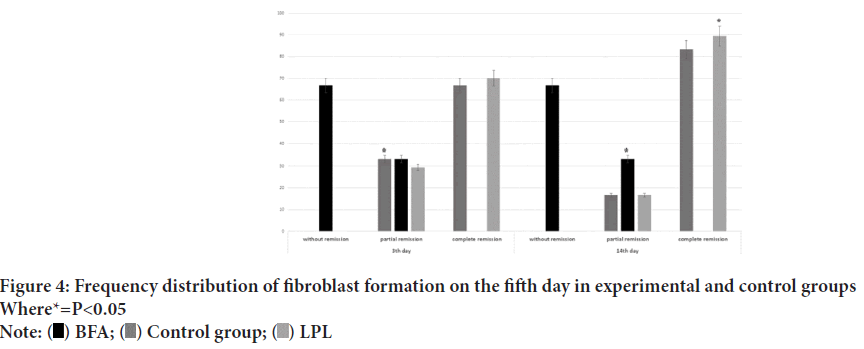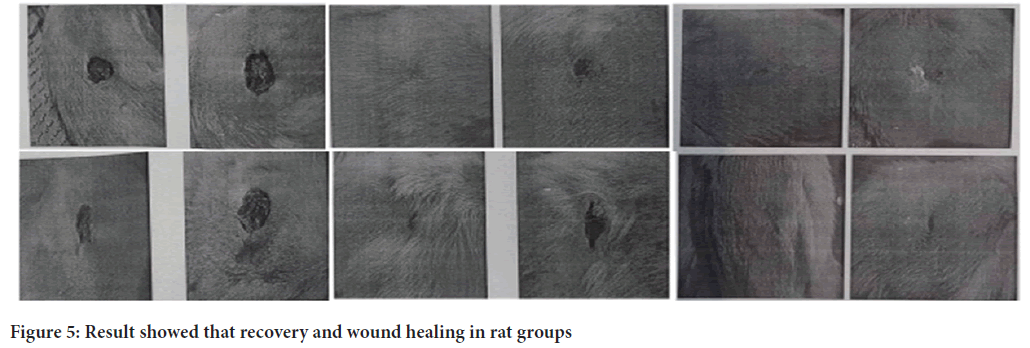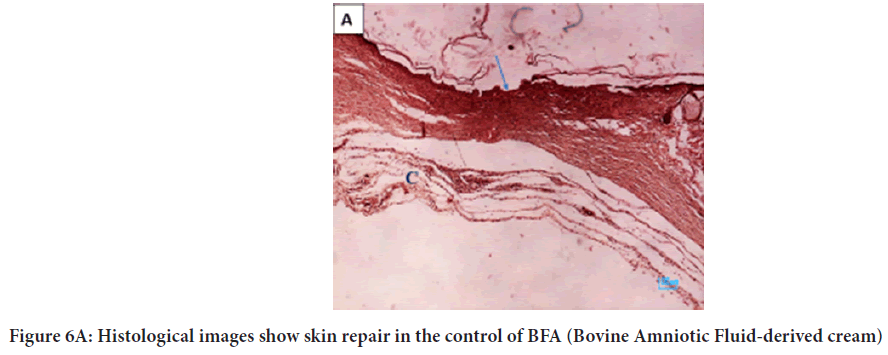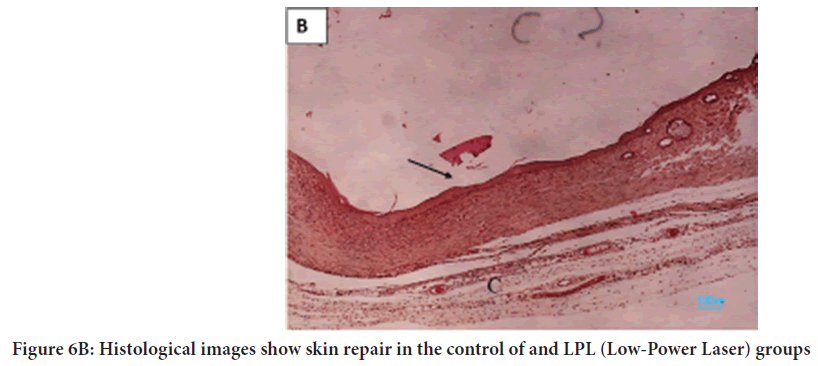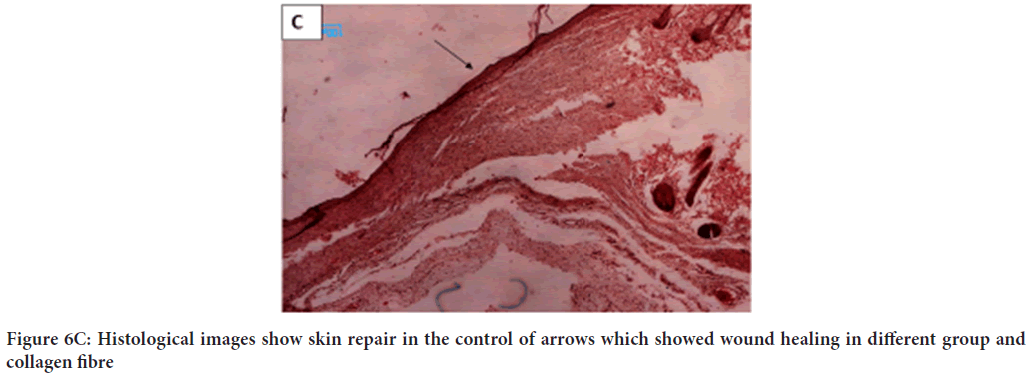Research Article - (2022) Volume 13, Issue 11
Low Level Laser and Bovine Amniotic Fluid-Derived Cream Accelerating Skin Neck Wound Healing and Reducing Inflammation and Wound Scar in Rat Animal Model
Davoud Abbasiazar1, Shamim Mollazadehghomi2,3, Arghavan Javadi4, Shahram Darabi2,3, Shabnam Mollazadehghomi5 and Hossien Abdali6*Abstract
Background: Nowadays, wound healing is one of the main problems of patients. Therefore, extensive research is underway to discover mechanisms associated with non-scarring of wounds. Using amniotic fluid and laser may potentially play a key role in wound healing and scar reduction due to its presence in tissue growth and repair agents.
Aim: The present study evaluated the effect of Bovine Amniotic Fluid-derived cream (BFA) and Low-Power Laser (LPL) on accelerating skin wound healing and reducing scarring in an animal model.
Methods: Therefore, 72 male Wistar rats were randomly divided into three groups (each group: 24). A wound 6 mm in diameter was then inflicted on the rats’ backs. In the first group that was the control group, the wound was only used. Moreover, a BFA was implemented for the second group, and in the third group, LPL radiation was utilized. On the 1st and 3rd, 5th, 14th, and 21st days, the healing condition of the wound and scar created was examined.
Results: Hence, evaluation of wound healing status on days 5 and 14 showed that the wound healing scale in the BFA group and LPL group was significantly better than the control group. On the 21st day, the average Scar Scoring Scale in the BFA and LPL groups was significantly lower than the control group. Histological images showed significant repair in the LPL and BFA groups.
Conclusion: To conclude, considering the positive effect of LPL and BFA on wound healing and less scarring, it seems that LPL and BFA can heal wounds faster. Moreover, they can be used to prevent scarring after wound healing.
Keywords
Amniotic fluid, Scar, Wound healing, Low power laser
Introduction
The skin is an effective barrier against adverse external conditions and has properties that can prevent microbial, mechanical, chemical, osmotic, and thermal damage (Childs DR and Murthy AS, 2017; Ashtiani HR, et al., 2018). Wound healing is a complex and dynamic process that affects the quality of life during recovery. It leads to high costs for the health system worldwide (Rodrigues M, et al., 2019). Adverse wound healing, especially in exposed areas of the body, is not attractive in appearance; however, it predisposes a person to tissue infection, necrosis, and other severe consequences. Scar formation and delay in wound healing are the main challenges in skin tissue trauma treatment (Basak PY, et al., 2002). Scar formation is caused by increased fibroblast activity during the wound healing process. When a wound form, the epidermis thickens, collagen and glycoprotein deposition increases, and collagen fibers become thicker than normal and parallel to the epithelium. Higher levels of β 1-TGF, I-Col, III-Col, fibronectin, and SMA-α have been observed in wounds compared to normal skin (Phan TT, et al., 2001). Despite advances in wound healing, the complexity of this process remains a significant clinical barrier. Some common treatments used to reduce or eliminate scars include surgery, corticosteroid injections, radiation therapy, topical silicone gel, and interferon injections. Due to the unknown mechanism of scar formation, treatment has been unsuccessful in most cases, so they have encountered various side effects (Sirinthipaporn A and Jiraungkoorskul W, et al., 2017). Some substances with specific conditions such as tissue oxygenation, small blood vessels, age, underlying diseases, decrease or increase in nutritional status, or drug interactions can reduce or increase the time required for tissue repair by affecting each step in the wound healing process be damaged (Vaisakh MN and Pandey A, et al., 2012). One of the substances that possibly contain a variety of molecules that may be involved in wound healing and scarring is amniotic fluid (Vijayaraghavan K, et al., 2017). This substance has been used in the healing of bone lesions. It has also been effective in healing damage to peripheral nerves and tendons. The effect of amniotic fluid on wound healing in the fetus has also been studied, and the presence of hyaluronic acid has been suggested as a possible reason (Sefati N, et al., 2018). In addition, the presence of stem cells in this fluid indicates the richness of the substances in it for cell growth. The advantages of this material are easy to access and low cost of its preparation, which can be used to repair skin wounds if it proves its effectiveness in accelerating the wound healing process and reducing the resulting scar (Basile M, et al., 2020). Due to the importance of this physiological process and to weave new factors affecting this process, by conducting this experimental study, the effect of LPL and BFA in each stage of tissue repair in the animal model will be studied.
Materials and Methods
Amniotic fluid preparation
Amniotic fluid was prepared from a pregnant cow in the 20th week after pregnancy using a veterinarian. In addition, the cow underwent veterinary examinations for no specific disease (TB or brucellosis).
Experimental groups
In this study, 72 male Wistar rats weighing 250-200 g were randomly divided into three groups (Each group: 24) and kept in temperature control and 12-hour light-dark cycle and standard feeding in the nest, after anesthesia with intravenous injection intra Peritoneal ketamine/xylocaine, and hair removal in the lumbar region was created with a skin puncture of a wound with a diameter of 6 mm in the lumbar region. After examining and observing the wound area for infection and bleeding, the closed containers were used on different days to maintain sterile conditions. On the 1st, 3rd, 5th, 14th, and 25th days, a group LPL (Diode laser, 810 nm, 60 s, 4 J/cm2) (Allameh M, et al., 2018) and a group of BFA were sacrificed according to the standard method, and skin sampling was performed on the wound area.
Sampling and analysis
Samples from the 1st, 3rd, and 5th days after wounding were counted in 5 microscopic fields. In terms of inflammatory cells and fibroblasts, neutrophils on the first day; macrophages, and lymphocytes on the third day; and lymphocytes and fibroblasts on the 5,15 days, respectively. The standard deviation of each percentage was calculated. Also, to examine the scar tissue in the samples related to the 5th day a microscopic field count was performed. Besides, its mean and standard deviation were calculated. To evaluate the collagen accumulation in the samples related to the 14th day, pathology analysis was used using Image Analysis Software (the pathology analysis software registered in the Supreme Informatics Council of Iran affiliated to President No. 102543). Wound healing scores were evaluated in samples related to days 5, 14, and 21 by 3 physicians without knowing the control and LPL, BFA groups, according to Krasner scoring. Finally, in the samples for the 21st day, the Oscar scoring criteria (20 and 16) were evaluated according to the Vancouver burn scar scoring.
Histological examination
Wound sampling was performed after sacrificing mice. First, the samples were fixed in 10% formalin for fixation. The tissues were then fixed, and 5-micron sections were prepared from the skin. Hematoxylin and eosin staining were finally performed.
Real time PCR
In this assay, gene RT-qPCR was performed on samples PE, (Applied Biosystems, CA). For a whole volume of 20 μl, the sample reactions contain SYBR green PCR master mixture (TaKaRa), cDNA template, primer forward and reverse, and distilled water. The level of relative gene (Bax, Bcl2, Caspase 3, GAPDH) expression was measured using the ΔΔCq method (Nooraei MS, et al., 2018; Darabi SH, et al., 2017). GAPDH was used to normalize gene expression. The primers sequence used are listed as follows in Table 1.
| Gene name | Product size | Sequence | Accession No |
|---|---|---|---|
| GAPDH | 175 | GTCTCCTCTGACTTCAACAGCG ACCACCCTGTTGCTGTAGCCAA |
NM_001256799.3 |
| BAX | 210 | TCAGGATGCGTCCACCAAGAAG TGTGTCCACGGCGGCAATCATC |
NM_001291428.2 |
| BCL2 | 194 | ATCGCCCTGTGGATGACTGAGT GCCAGGAGAAATCAAACAGAGGC |
NM_000633.3 |
| CASPASE3 | 220 | GGAAGCGAATCAATGGACTCTGG GCATCGACATCTGTACCAGACC |
NM_004346.4 |
Table 1: Primers sequence used for the assay
Statically analysis
After collecting and editing, the data were entered into the computer and analyzed by SPSS software version 24. The following tests were implemented to analyze the data. Student T-test to compare between quantitative data of two samples, Chi-square test to compare between qualitative data, and Mann-Whitney test for comparison between ranking data were utilized.
Atropine sulphate 1% w/v drops (available commercially-Jawa Pharmaceuticals (India) Pvt.
Results
In the present study, 72 male rats were selected and randomly assigned to 3 groups. Then, a 6 mm wound was made on the back of the mice, no treatment was used for the control group, and 1 ml of BFA was applied topically for the experimental group. Then, on the first and third days, the type and severity of inflammation were evaluated. On the fifth day, the type and severity of inflammation were re-evaluated. In addition, fibroblast, angiogenesis, and wound healing scale were evaluated. On the 14th day, collagen accumulation was examined, and the wound healing scale was re-evaluated (Table 2). Finally, on the twenty-first day, the scar storing scale was evaluated.
| Score | Area | Depth | Infection | Ready for autograft | Epithelialization | Condition of sore bed |
|---|---|---|---|---|---|---|
| 2 | - | - | - | - | Complete | Healed |
| 2 | Decreased | Decreased | No | Yes | Well in minimum time | Excellent |
| 1 | Unchanged | Unchanged | No | No | Good | Good |
| 0 | Increased | Increased | Yes | No | Hasn’t done well | Bad |
Table 2: Wound healing scoring scale
Inflammation
On the first day, the severity of inflammation was evaluated in the LPL, BFA, and control group, in which for 4 samples the severity of inflammation was +4 and for 2 samples was +3. If in the control group all 6 samples had inflammation of +3 and according to Whitney test, the severity of inflammation on the first day was significantly different in the experimental and control groups (p=0.019). On the first day, the type of inflammation was acute in all samples and there was no case of subacute or chronic inflammation. The results are shown in Figure 1.
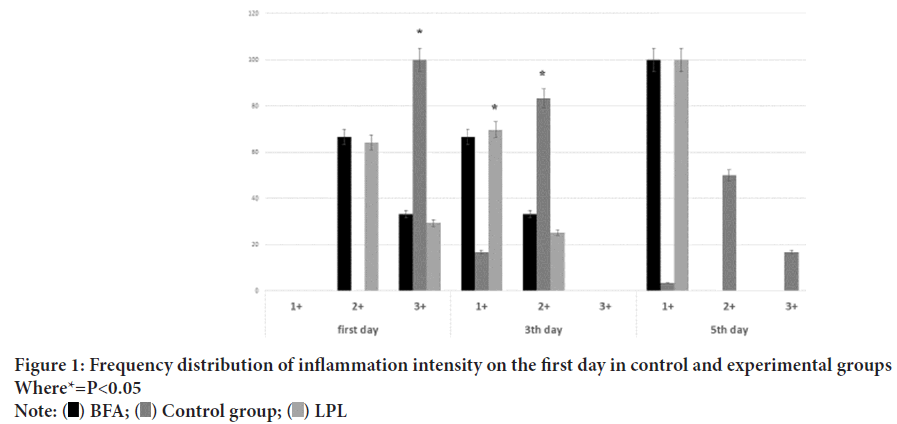
Figure 1: Frequency distribution of inflammation intensity on the first day in control and experimental groups
Where*=P<0.05 Note:  BFA;
BFA;  Control group;
Control group;  LPL
LPL
On the third day, in LPL, BFA groups, and control group, inflammation was observed +1 and also inflammation +2. In addition, there was no case of severity of inflammation +3 in any of the samples. Mann-Whitney statistics on these data showed that the severity of inflammation on the third day was not significantly different between the two groups (P=0.093). On the third day, some samples BFA and LPA groups had subacute inflammation (66.7%) and some had chronic inflammation (33.3%). There was also no case of acute inflammation in any of the samples (Figure 2). On the 5th day, all samples in LPL, BFA groups had +1 inflammation, while in the control group, 2 samples had +1 inflammation, 3 samples had +2 inflammations and 1 case had inflammation of +3. Mann-Whitney test also showed that the severity of inflammation on the 5th day in the LPL group was significantly lower (p=0.021). On the 5th day, there were no samples with acute inflammation in the experimental groups, but in the control group, 1 sample had acute inflammation. Also, on the fifth day, there was no case of subacute inflammation, while in the control group, 3 samples had subacute inflammation, and all samples in the LPL, BFA group had chronic inflammation, but in the control group, 2 samples had chronic inflammation (Figure 3).
Figure 2: Frequency distribution of inflammation intensity on the 1,2 and three day in control and experimental groups
Where*=P<0.05 Note:  BFA;
BFA;  Control group;
Control group;  LPL
LPL
Figure 3: Frequency distribution of inflammation intensity on the five day in control and experimental groups
Where*=P<0.05 Note:  BFA;
BFA;  Control group;
Control group;  LPL
LPL
Fibroblast formation
On the fifth day of the intervention (Figure 4), the samples were examined for fibroblast formation, angiogenesis, and wound healing score. The status of fibroplasia was examined in all groups, of which 2 samples from the experimental groups had +3 fibroblasts and 4 samples had +3 fibroblasts. In the control group, 5 samples had +1 fibroblasts and 1 sample had no fibroblasts. Fisher’s exact test on these data also showed that fibroblast formation was significantly higher in the LPL, BFA group comparison to the control group (P=0.002).
Figure 4: Frequency distribution of fibroblast formation on the fifth day in experimental and control groups
Where*=P<0.05 Note:  BFA;
BFA;  Control group;
Control group;  LPL
LPL
Angiogenesis
The mean angiogenesis in the experimental and control groups was 11.7. 3.7, 6.5, 1.9, 9.1, and 3.9 respectively, and according to the student T-test, the mean angiogenesis in the case group was significantly higher (P=0.013). The results are illustrated in Table 3.
| Group | Angiogenesis percent | Standard deviation |
|---|---|---|
| LPL | 11/7 | 3/7 |
| Control | 6/5 | 1/9 |
| BFA | 1/9 | 3/9 |
Table 3: Comparison of mean and standard deviation of angiogenesis in the two groups Wound healing status
On the fifth day, out of 6 samples from the experimental group, 2 samples had partial wound healing and 4 samples had complete wound healing, but in the control group, 4 samples, no wound healing, and 2 samples had partial wound healing. Fisher’s exact test also showed that the wound healing status in the case group was significantly better (P=0.039). Results for the On the fourteenth day, 6 samples from the experimental groups and 6 samples from the control group were examined for wound healing status and collagen tissue formation at the wound site. 5 samples from the experimental group had complete wound healing. And the sample had a relative wound healing. In the control group, 4 samples had no wound healing and 3 samples had relative wound healing. Fisher’s exact test also showed that the wound healing status on the fourteenth day in the case group was significantly more favorable (P=0.006).
Collagen tissue formation
Table 4shows the frequency distribution of collagen accumulation intensity in the two groups and according to the Mann-Whitney test, the collagen accumulation intensity in experimental groups was significantly higher than the control group (P=0.037).
Wound scar score
On the 21st day, the rest of the samples, which included 12 samples from the experimental groups and 13 samples from the control group, were examined and 2 scar scoring scales were examined in them; the mean Scar scoring scale in the control and experimental groups was 4.1. 1.2 and 5.6 6 1.6, respectively, and according to the scar scoring test. Student t in the case group was significantly lower (P=0.025). The results are presented in Table 4.
| Groups collagen |
BFA | Control | LPL | |||
|---|---|---|---|---|---|---|
| Number | Percent | Number | Percent | Number | Percent | |
| 1+ | 0 | 0 | 2 | 33/3 | 2 | 16/7 |
| 2+ | 0 | 0 | 3 | 50 | 3 | 25 |
| 3+ | 2 | 33/3 | 0 | 0 | 2 | 16/7 |
| 4+ | 4 | 66/7 | 1 | 16/7 | 5 | 41/7 |
| Total | 6 | 100 | 6 | 100 | 12 | 100 |
Table 4: Comparison of mean and standard deviation of wound scar in two groups
Histological result
Figures 5 and 6A-6C showed that the macroscopically and histologically changes in LPL, BFA, and control group. The results showed that after skin lesion and healing in different groups, the rate of improvement in the laser and fluid group was faster than in the control group. Histological images showed that fibroblasts and collagen increased in the wound healing area, indicating a positive effect of LPL and BFA.
Figure 5: Result showed that recovery and wound healing in rat groups
Figure 6A: Histological images show skin repair in the control of BFA (Bovine Amniotic Fluid-derived cream)
Figure 6B: Histological images show skin repair in the control of and LPL (Low-Power Laser) groups
Figure 6C: Histological images show skin repair in the control of arrows which showed wound healing in different group and collagen fibre
Real time PCR
To estimate mRNA expression of target genes at the molecular level, the number of transcriptions of three genes which were involved in apoptosis Bcl2, Bax, and Caspase3 were examined in the samples. Bcl2 expression levels in the control group were remarkably lower than in the experimental group (P<0.5). The experimental group’s Bax and Caspase3 expression levels were greater than the control group (P<0.01).
Discussion
The overall aim of this study was to determine the effect of LPL and BFA in accelerating skin wound healing and reducing wound scarring in an animal model. Recent clinical and empirical evidence suggests a fundamental difference between fetuses and adults in terms of injury; fetal skin lesions heal quickly and without scarring. This phenomenon was first observed clinically during fetal surgery experience, and a new trade in several animal embryo models has supported the clinical observation of scar-free fetal wound healing. Progressive research has begun to elucidate the unique mechanism of wound healing in the fetus, and the process of fetal wound healing may provide a model for ideal wound healing in adults (Nyman E, et al., 2013; Clanton TO, et al., 2020). Unlike chronic non-healing bone healing wounds, there is usually little concern about the time it takes for tissue to re-integrate and its tensile strength after injury, but the important point is to restore tissue structure and normal function without scarring. In one study, the effect of amniotic fluid on preventing intra-abdominal adhesions after laparotomy in rats was investigated and its effectiveness was emphasized. In another study, amniotic fluid improved peripheral nerve regeneration and had a preventive effect on epineuria scars. Another study demonstrated the effectiveness of the topical application of amniotic fluid in accelerating the corneal epithelialization. In another study, topical application of amniotic fluid after tenorrhaphy had a significant effect on preventing the formation of adhesions around the tendon without impairing tendon healing in the animal model (Decoppi P, et al., 2007). Numerous other studies have been performed on each of the growth factors that are abundant in amniotic fluid and are effective in wound healing (Kim YS, et al., 2011; Baumann ME, et al., 2021). One possible mechanism for accelerating wound healing and scarring in the fetus is its placement in amniotic fluid rich in hyaluronic acid and other growth factors such as TGF-B is VEGF PDGF and so on. Therefore, it seems that one of the substances with different types of molecules that may be effective in the wound healing process and reducing its scar is amniotic fluid (Krasner D, 1997; Yao CH, et al., 2017). Also, the presence of stem cells in this fluid indicates that it is rich in cell growth. Given the importance of the physiological process of wound healing and intending to find new factors affecting this process, we undertake an experimental study of the effect of using BFA on the wound healing process and it’s scarring in the animal model. In this study, in a group of rats that used BFA and LPL in their wounds, the type and severity of inflammation were significantly lower and the inflammation disappeared in a shorter time in the control group. Therefore, the effect of BFA and LPL can be considered effective in reducing inflammation. The effects of LPL in the treatment of various diseases have been reported to be consistent with the results of our study (Yates CC, et al., 2012; Mirakabad FS, et al., 2020). The status of fibroblast formation was examined in different groups, the results showed that LPL and BFA have positive effects on this process. The mean angiogenesis in LPL, BFA, and control groups was 11.7. 3.7, 6.5, 1.9, 9.1, and 3.9 respectively, and the mean angiogenesis was higher in the case group. However, angiogenesis should be lower in the group receiving the BFA, which may be related to other interfering factors during wound healing. Other variables such as collagen tissue formation and wound healing status and wound scar score in the LPL and BFA group were significantly more favorable than the control group.
Conclusion
Finally, this study indicates the effectiveness of BFA and LPL in reducing inflammation, increasing fibroplasia, increasing angiogenesis, increasing collagen formation, as well as improving wound healing and reducing scarring, but for a definitive conclusion, this study needs to be performed on a larger scale. Considering the positive effect of BFA and LPL in improving wound healing and less scarring, it seems that with the continuation of research, it will be possible in the future for a drug containing amniotic fluid with similar synthetic compounds to heal wounds faster and prevent scarring. LPL has recently been used to treat skin wounds and positive results have been obtained. Considering the positive effect of bovine amniotic fluid cream on wound healing and less scarring compared to the laser group, it seems that with the continuation of research, in the future, a drug containing amniotic fluid or similar synthetic compounds can heal wounds faster and use to prevent scarring after wound healing.
Ethics Approval
The protocols of this study are confirmed by the ethical committee of Esfahan University of Medical Sciences.
Acknowledgment
We are thankful for the funding provided by the school of medicine, Esfahan University of Medical Sciences, Esfahan, Iran.
Data Availability
All data generated or analyzed during this study are included in this article.
References
- Childs DR, Murthy AS. Overview of wound healing and management. Surg Clin North Am. 2017; 97(1): 189-207.
[Crossref] [Google scholar] [Pubmed]
- Ashtiani HR, Akaberi M, Nilforoushzadeh MA, Farahani M. Repairing injured skin: Biologics, skin substitutes, and scaffolds. J Skin Stem Cell. 2018; 5(4).
- Rodrigues M, Kosaric N, Bonham CA, Gurtner GC. Wound healing: A cellular perspective. Physiol Rev. 2019; 99(1): 665-706.
[Crossref] [Google scholar] [Pubmed]
- Basak PY, Eroglu E, Altuntas I, Agalar F, Basak K, Sutcu R. Comparison of the effects of tretinoin, adapalene and collagenase in an experimental model of wound healing. Eur J Dermatol. 2002; 12(2): 145-148.
[Google scholar] [Pubmed]
- Phan TT, Hughes MA, Cherry GW. Effects of an aqueous extract from the leaves of Chromolaena odorata (Eupolin) on the proliferation of human keratinoctes and on their migration in an in vitro model of reepithelializations. Wound Repair Regen. 2001; 9(4): 305-313.
[Crossref] [Google scholar] [Pubmed]
- Sirinthipaporn A, Jiraungkoorskul W. Wound healing property review of siam weed, Chromolaena odorata. Pharmacog rev. 2017; 11(21): 35.
[Crossref] [Google scholar] [Pubmed]
- Vaisakh MN, Pandey A. The invasive weed with healing properties: A review on Chromolaena odorata. Int J Pharm Sci Res. 2012; 3(1): 80.
- Vijayaraghavan K, Rajkumar J, Seyed MA. Efficacy of Chromolaena odorata leaf extracts for the healing of rat excision wounds. Vet Med. 2017; 62(10): 565-578.
- Sefati N, Abbaszadeh HA, Fathabady FF, Abdollahifar MA, Khoramgah MS, et al. The combined effects of mesenchymal stem cell conditioned media and low-level laser on stereological and biomechanical parameter in hypothyroidism rat model. J Lasers Med Sci. 2018; 9(4): 243.
[Crossref] [Google scholar] [Pubmed]
- Basile M, Marchegiani F, Novak S, Kalajzic I, di Pietro R. Human amniotic fluid stem cells attract osteoprogenitor cells in bone healing. J Cell Physiol. 2020; 235(5): 4643-4654.
[Crossref] [Google scholar] [Pubmed]
- Allameh M, Khalesi S, Khozeimeh F, Faghihian E. Comparative evaluation of the efficacy of laser therapy and fibroblastic growth factor injection on mucosal wound healing in rat experimental model. J Lasers Med Sci. 2018; 9(3): 194.
[Crossref] [Google scholar] [Pubmed]
- Nooraei MS, Noori-Zadeh A, Darabi S, Rajaei F, Golmohammadi Z, Abbaszadeh HA. Low level of autophagy-related gene 10 (ATG10) expression in the 6-hydroxydopamine rat model of parkinson’s disease. Iran Biomed J. 2018; 22(1): 15.
[Crossref] [Google scholar] [Pubmed]
- Darabi SH, Tiraihi T, Noori-Zadeh A, Rajaei F, Darabi L, Abbaszadeh H. Creatine and retinoic acid effects on the induction of autophagy and differentiation of adipose tissue-derived stem cells into GABAergic-like neurons. J Babol Univ Med Sci. 2017; 19(8): 41-49.
- Nyman E, Huss F, Nyman T, Junker J, Kratz G. Hyaluronic acid, an important factor in the wound healing properties of amniotic fluid: In vitro studies of re-epithelialisation in human skin wounds. J Plast Surg Hand Surg. 2013; 47(2): 89-92.
[Crossref] [Google scholar] [Pubmed]
- Clanton TO, Mullens JH, Schon LC, Tartaglione JP. Achilles tendon disorders including tendinopathies and ruptures. Baxter's The Foot and Ankle in Sport. 2020.
- Decoppi P, Callegari A, Chiavegataa A, Gasparotto L. Piccoli M, Taiani J, et al. Amniotic fluid and bone marrow derived mesenchymal stem cells can be converted to smooth muscle cells in the cryo-injured rat bladder and prevent compensatory hypertrophy of surviving smooth muscle cellss. J urol. 2007; 177(1): 369-379.
[Crossref] [Google scholar] [Pubmed]
- Kim YS, Cho IH, Jeong MJ, Jeong SJ, Nah SY, Cho YS, et al. Therapeutic effect of total ginseng saponin on skin wound healing. J Ginseng Res. 2011; 35(3): 360.
[Crossref] [Google scholar] [Pubmed]
- Baumann ME, DeBruler DM, Blackstone BN, Coffey RA, Boyce ST, Supp DM, et al. Direct comparison of reproducibility and reliability in quantitative assessments of burn scar properties. Burns. 2021; 47(2): 466-478.
[Crossref] [Google scholar] [Pubmed]
- Krasner D. Wound healing scale, version 1.0: A proposal. Adv Wound Care. 1997; 10(5): 82-85.
[Google scholar] [Pubmed]
- Yao CH, Lee CY, Huang CH, Chen YS, Chen KY. Novel bilayer wound dressing based on electrospun gelatin/keratin nanofibrous mats for skin wound repair. Mater Sci Eng C Mater Biol Appl. 2017; 79: 533-540.
[Crossref] [Google scholar] [Pubmed]
- Yates CC, Hebda P, Wells A. Skin wound healing and scarring: Fetal wounds and regenerative restitution. Birth Defects Res C Embryo Today. 2012; 96(4): 325-333.
[Crossref] [Google scholar] [Pubmed]
- Mirakabad FS, Khoramgah MS, Tahmasebinia F, Darabi S, Abdi S, Abbaszadeh HA, et al. The effect of low-level laser therapy and curcumin on the expression of LC3, ATG10 and BAX/BCL2 ratio in PC12 cells induced by 6-hydroxide dopamine. J Lasers Med Sci. 2020; 11(3): 299.
[Crossref] [Google scholar] [Pubmed]
Author Info
Davoud Abbasiazar1, Shamim Mollazadehghomi2,3, Arghavan Javadi4, Shahram Darabi2,3, Shabnam Mollazadehghomi5 and Hossien Abdali6*2Department of Cellular and Molecular research, Qazvin University of Medical Sciences, Qazvin, Iran
3Department of Non-Communicable Diseases, Qazvin University of Medical Sciences, Qazvin, Iran
4Department of Medicine, Rafsanjan University of Medical Sciences, Rafsanjan, Iran
5Department of Medicine, Iran University of Medical Sciences, Tehran, Iran
6Department of Surgery, School of Medicine, Esfahan University of Medical Sciences, Esfahan, Iran
Citation: Abbasiazar D: Low Level Laser and Bovine Amniotic Fluid-Derived Cream Accelerating Skin Neck Wound Healing and Reducing Inflammation and Wound Scar in Rat Animal Model
Received: 20-Oct-2022 Accepted: 03-Nov-2022 Published: 10-Nov-2022, DOI: 10.31858/0975-8453.13.11.778-784
Copyright: This is an open access article distributed under the terms of the Creative Commons Attribution License, which permits unrestricted use, distribution, and reproduction in any medium, provided the original work is properly cited.
ARTICLE TOOLS
- Dental Development between Assisted Reproductive Therapy (Art) and Natural Conceived Children: A Comparative Pilot Study Norzaiti Mohd Kenali, Naimah Hasanah Mohd Fathil, Norbasyirah Bohari, Ahmad Faisal Ismail, Roszaman Ramli SRP. 2020; 11(1): 01-06 » doi: 10.5530/srp.2020.1.01
- Psychometric properties of the World Health Organization Quality of life instrument, short form: Validity in the Vietnamese healthcare context Trung Quang Vo*, Bao Tran Thuy Tran, Ngan Thuy Nguyen, Tram ThiHuyen Nguyen, Thuy Phan Chung Tran SRP. 2020; 11(1): 14-22 » doi: 10.5530/srp.2019.1.3
- A Review of Pharmacoeconomics: the key to “Healthcare for All” Hasamnis AA, Patil SS, Shaik Imam, Narendiran K SRP. 2019; 10(1): s40-s42 » doi: 10.5530/srp.2019.1s.21
- Deuterium Depleted Water as an Adjuvant in Treatment of Cancer Anton Syroeshkin, Olga Levitskaya, Elena Uspenskaya, Tatiana Pleteneva, Daria Romaykina, Daria Ermakova SRP. 2019; 10(1): 112-117 » doi: 10.5530/srp.2019.1.19
- Dental Development between Assisted Reproductive Therapy (Art) and Natural Conceived Children: A Comparative Pilot Study Norzaiti Mohd Kenali, Naimah Hasanah Mohd Fathil, Norbasyirah Bohari, Ahmad Faisal Ismail, Roszaman Ramli SRP. 2020; 11(1): 01-06 » doi: 10.5530/srp.2020.1.01
- Manilkara zapota (L.) Royen Fruit Peel: A Phytochemical and Pharmacological Review Karle Pravin P, Dhawale Shashikant C SRP. 2019; 10(1): 11-14 » doi: 0.5530/srp.2019.1.2
- Pharmacognostic and Phytopharmacological Overview on Bombax ceiba Pankaj Haribhau Chaudhary, Mukund Ganeshrao Tawar SRP. 2019; 10(1): 20-25 » doi: 10.5530/srp.2019.1.4
- A Review of Pharmacoeconomics: the key to “Healthcare for All” Hasamnis AA, Patil SS, Shaik Imam, Narendiran K SRP. 2019; 10(1): s40-s42 » doi: 10.5530/srp.2019.1s.21
- A Prospective Review on Phyto-Pharmacological Aspects of Andrographis paniculata Govindraj Akilandeswari, Arumugam Vijaya Anand, Palanisamy Sampathkumar, Puthamohan Vinayaga Moorthi, Basavaraju Preethi SRP. 2019; 10(1): 15-19 » doi: 10.5530/srp.2019.1.3







